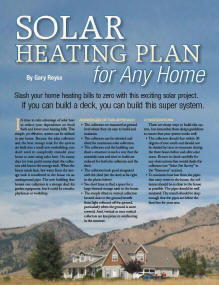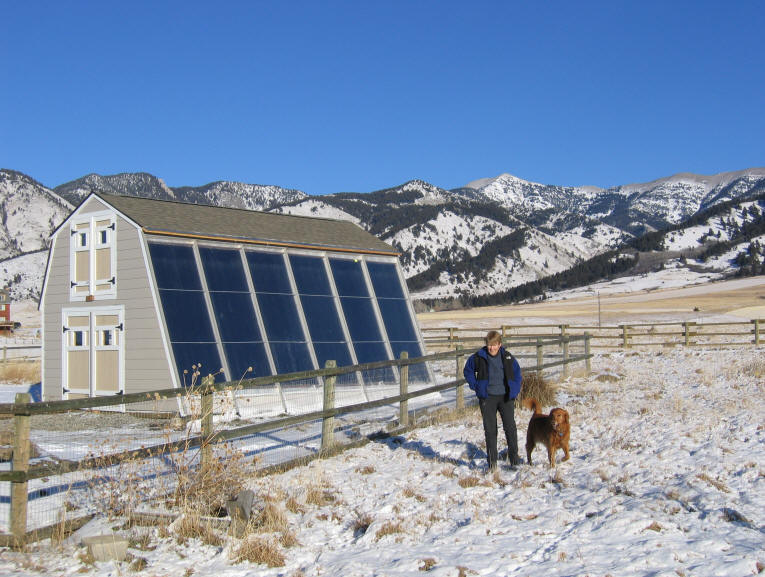Update: October 20, 2018
Have not done an update for some time, so here is the latest...
The system is still working fine. All of the original components (pumps, controller, ...) are still working with no failures or replacements. The system has not required any repairs over its 12 year life so far. In some very small areas, the inner layer of the double wall polycarbnate glazing shows some degradation due to overheating, but only in some very limited areas with no real impact on performance. This glazing issue has to do with using both a collector absorber with a selective coating in combination with the double glazing causing the collectors to run very hot when the sun is on them and water is not flowing through them. If I were doing the collector again, I'd use the twin wall polycarbonate glazing along with an absorber that is just painted black (no selective coating -- this is an easy DIY approach and has good performance) similar to the collector on the $2K solar water/space heating system.
The system has operated for 11 winters. With a saving of about 340 gallons of propane per year at a nominal $2 llal on, the savings are $7500 compared to an initial cost of materials of about $4200. So, it has paid back nearly twice its cost of materials so far and I expect it to run for many more years. The yearly return on the invested $4200 is about 18%. The cumulative reduction in CO2 emissions is about 56,000 lbs.
I did not operate the system through the winter of 2017. The reason has to do with having some trouble getting the system started in the fall, being away from the house for a lot of the winter, and some lazyness on my part.
Update: December 9, 2013
--
For the first time since the system was built in 2006, we had a small freeze problem. One of the two pipes going from the tank to the house froze in the area right next to the tank. This section of pipe right next to the tank is exposed to outside temperatures. I took pains to insulate it well and try to arrange things so that a little heat from the tank got to the pipes, but I guess the full week of temperatures down to -20F were a little too much for it.
I easily got the pipe thawed by putting a heater tape in the insulated cavity near the pipe. There was no freeze damage to any of the pipes, and the system was up and running again with only half a day lost.
The heater tape is thermostatically controlled and runs very little to keep the pipe area around the pipe above freezing -- even in this bitter cold weather, it only takes an average power draw of about 5 watts to keep the area above freezing, but I will probably see if I can do a better job on the insulation and eliminate the heater tape.
The pipe lines from the shed to the house are buried 4 ft down, so freezing is not an issue except where the pipe comes up next to the tank.
The collector loop operated through this long spell of cold weather with no problems.
Otherwise, the system startup in the Fall with no problems and has been run with no incidents or problems.
Update: October 31, 2011
-- Happy Halloween!
Not much new to report the last couple years. The system started
up fine -- basically just flip a couple switches.
I did loose a glazing panel in a big windstorm. This was
carelessness on my part as I had taken off one of the glazing cap strips to
place a logging sensor under the glazing and I decided to replace some of
the screws with plastic coated deck screws -- while I was waiting to pick
those up in town, I just had the cap strip loosely secured, and then the
windstorm came.
I found the twinwall glazing panel a quarter mile away in the neighbors
field. It had a couple not bad scratches on it, but otherwise fine.
I reinstalled it. Polycarbonate is pretty tough!
I do strongly recommend that people thinking about this project read through
this newer space heating project --
its very thoroughly documented and has a few lessons learned over the past
few years by me and others.
Update: October 3, 2009
--System startup for the 2009 - 2010 heating season.
I started up the Solar Shed yesterday after the summer shutdown.
I started up just fine -- no hitches, took 2 minutes.
I started it just before noon, and the tank went from 60F to 110F by the end
of the day.
Likewise, the startup of the radiant floor heating system that draws hot
water from the storage tank and pumps it through the radiant floor was also
uneventful.
At 4:30 pm, Oct 3, the tank is at 129F, and provided some heat last night
and all day today -- its been cold the last couple days with some snow, so
the system is doing some work even at this early date.
I put these little updates in just to reassure people that the system is
alive and well -- if there are problems with it over time, I will post them
-- honest :)
Updated:
1/15/07 -- Added the "Heat Distribution to House" and "Performance"
sections, and a few new comments at the end of the "Shed and Collector", "The
Trench", and the "Storage Tank" sections.
Finished the first few radiant
floor loops for the house, and started using heat from the system on 1/12/07.
Instead of installing solar
collectors on the south roof of the house, the collectors are installed on
a new garden shed that was designed for them. The new shed thus provides the
following functions: 1) holds garden equipment, 2) provides a good space for solar
collectors (pointed in the right direction for good collection), and 3) provides
space for
a large water tank to store heat. Heated water from the storage tank in the
garden shed is circulated to the
house as needed for space heating.
I should mention that we live in SW
Montana at 46 degrees north latitude. Winters are chilly -- 8000
degree-days and down to -30F once in a great while -- with typical mid-winter highs
in the 30F's. But, a fair number of sunny days
that are a pleasant indeed.
South of shed wall with integrated solar water heating collectors being built.
The assembled absorber plates were purchased, and the collector
housing and glazing were site built, and integrated with the wall.
The combination Garden Shed and Solar
Collector System. The South
wall/roof slopes at 70 degrees, and has
The collectors are integrated with
the south face of the shed -- the shed and the collectors share elements such
that each benefits from the other. For example, the collector glazing
eliminates the need for siding and roofing on the south side of the shed, and
the collector support structure is one in the same with the south wall of the
shed.
These are my initial thoughts on the
pluses and minus of this type of system (feedback welcome):
Use the links in the Directory above
to see more detail on the various components.



